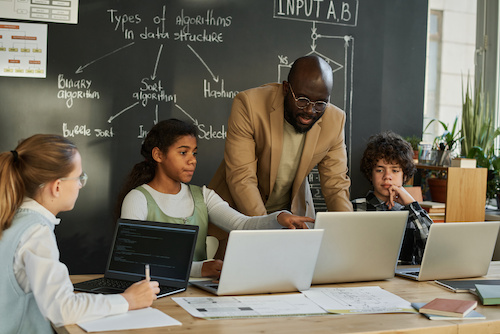Key points:
- Stay up to date on the latest trends about learning in the digital age
Editor’s note: This story on collaborative learning originally appeared on CoSN’s blog and is reposted here with permission.
Artificial Intelligence (AI) has been around for many years, but the introduction of ChatGPT in November 2022 has generated many discussions of how this technology can impact education – both how students learn and how educators teach.
While new and emerging technologies can feel like a hurdle at times, there is also much that can be gained by incorporating them into our curriculum. And those benefits are even greater when educators and students learn together, especially as we navigate new tech enablers like AI apps and tools.
Technology’s effect on teachers
Individuals who struggled to use technology have argued that the incorporation of too much technology is one of the reasons for teacher burnout. Technology use and implementation have been challenging in the classroom, but AI technologies, like ChatGPT, have made it even more controversial. The fear of technology plays a large role in the hesitation of adopting technology in the classroom. This could be due to a combination of many reasons: fear of change, lack of training, effectiveness of technology, pace of learning, and new technology trends, to name a few. To overcome these obstacles, collaboration and communication are key.
How technology impacts student learning
Current school-aged students have been growing up with technology, and they are often comfortable using the technology. If we want to create learning environments where students can thrive, we need to foster learning environments where students can learn effectively. This does not mean teachers have to be experts in using all technologies, but teachers should be willing to incorporate technology into their everyday curriculum delivery. Fear of technology influences a teacher’s thinking, perhaps thinking that many students have more knowledge of the technology. Most of the time, this is not true. Students may know how to use some technology, but not all. If the teacher and student collaborate and start learning technology together, it would be beneficial for both teachers and students.
Mutual benefits of learning technology…together
Learning together with students can provide several benefits for teachers and students to support the overall learning process. Some of the advantages can be:
Enhanced Learning: There are many educational technologies available including online courses, simulations, virtual reality, and gamification. This would not only allow students to enhance their learning but also teachers to incorporate new teaching methods to support students in different learning environments.
Student-Centered Learning: The incorporation of technology allows learning to be more student-centered rather than teacher-centered learning. Student and teacher collaboration promotes an effective understanding of different concepts.
Effective Assessment: Digital tools make it easier for teachers to create and grade assignments, quizzes, and exams. It also allows opportunities to increase constructive feedback to students and teachers to modify and adapt different teaching strategies for students.
Accessibility: The use of the internet allows students and teachers to access and research information quickly and effectively to support self-improvement. Access to academic websites, online libraries, and other educational resources provides knowledge at their fingertips.
Flexibility: Learning and teaching with technology provides flexibility since it can take place anywhere. This will promote self-paced learning among students and curriculum resources can be accessed anytime.
Engagement: Gamification tools will make learning more fun and engaging for students. These tools can allow teachers to create dynamic and engaging lessons to motivate students.
Modern Skills: Today’s modern workforce requires digital literacy skills. The use of technology will not only prepare students for this environment but allow them to be proficient in the use of different software, analysis tools, and digital communication.
Data-Driven Decisions: Educational technology will allow us to collect data and generate individual student reports. Teachers can use this information to provide additional support to students who may be struggling.
Lifelong Learning: Students and teachers are encouraged to adopt new technologies together, which promotes adaptation of new tools and commitment to continuous improvement. It also allows students to share ideas with other individuals around the world to enrich their learning experiences.
Moving forward in synch
Successful integration of technology into the curriculum is not possible without thorough planning and ongoing support. Technology should not take over every teaching method, but there should be a balance between the use of educational technology and traditional teaching methods to support varied education opportunities for students. Learning together will promote collaboration and communication among teachers and students, which is imperative as we incorporate generative AI and emerging technologies into the classroom.
Related: Leveraging the K-12 generative AI readiness checklist: A guide for district leadership
- 5 ways school districts can create successful community partnerships - November 21, 2024
- Trump picks Linda McMahon to lead, and possibly dismantle, Education Department - November 21, 2024
- 6 ways to create engaging elementary learning spaces - November 20, 2024


